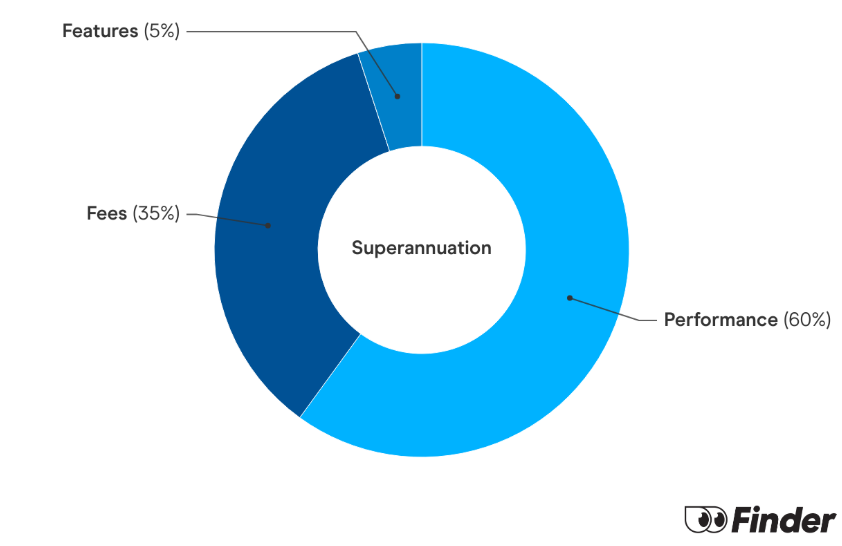Key takeaways
- You can choose which super fund to join, and you can switch choices at any time.
- Most people are in 'balanced' super options, which are often the default MySuper products offered by funds.
- The key features to look for are low fees, high long-term returns and an investment strategy you agree with.
How to choose a super fund
1. Choose your investment option
Not only do you get to choose your super fund, but also the investment option within that super fund.
Here's an overview of the types of super investment options availabe, along with their general asset mixes. More investment allocation into growth asstes (like shares) comes with more risk in the short term, but aims for more reward in the long term.
Conservative funds:
- Risk level: Low - medium (invests 21-40% of balance into growth assets)
- Asset mix: Primarily lower-risk investments like bonds and cash, with a smaller portion in shares and property. These funds aim for stable returns and lower risk, ideal for those who prefer a cautious investment approach or are close to retirement.
Balanced funds:
- Risk level: Medium - high (invests 61-80% of balance into growth assets)
- Asset mix: A diversified portfolio that includes shares, property, bonds, and cash. These funds aim to achieve a balance between risk and growth, making them a popular choice for a wide range of investors, particularly as a default option set by employers and the fund's MySuper option.
High growth funds:
- Risk level: High - very high (invests 81-100% of balance into growth assets)
- Asset mix: Mainly high-risk investments like shares and property. These funds target higher returns over the long term but come with greater volatility and risk in the short term. They are typically chosen by members with a longer investment horizon and a higher tolerance for market fluctuations.
Single asset class funds:
- Risk level: Low - Very High
- Asset mix: These funds concentrate on a single asset class, such as Fixed Income, Australian Shares (Aust Shares), International Shares (Int'l Shares), or Property. By focusing on one type of asset, these funds offer a more targeted investment approach but with higher risk due to lack of diversification. However, investing 100% in Fixed Income would have significantly lower risk than investing 100% in International Shares.
You can also choose an ethical super fund if you'd like your super to be invested more sustainably into things like renewable energy.

"For younger investors with over 30 years until retirement, opting for a high-growth superannuation fund can be strategic. However, not all high-growth options are the same. One fund might allocate 80% to growth assets, while another allocates 95%, leading to different outcomes. It's crucial to look beyond labels and understand how each fund invests your money."
2. Pick a fund with great returns
Once you've decided which type of investment option you'd like to go with, you can compare the returns from a number of different super funds.
Make sure you focus on the average returns over an extended period, like 10 years, as this provides a more accurate picture of the fund's long-term performance through various market cycles.
Balanced funds: Look for a balanced fund that has returned at least 7% p.a. over the past 10 years.
Conservative funds: A good benchmark would be a fund that has returned at least 5% p.a. over the past 10 years.
High growth funds. Look for a high growth option that has returned at least 9-10% p.a. over the past 10 years.
To show the impact of even a 2% difference in returns, let's use Finder's superannuation calculator to consider different hypothetical examples.
Let's say you're 25, earning $80,000 a year, making no additional contributions and have a current super balance of $30,000. Your annual fees are $300.
| Starting balance | Annual fees | Return rate | Additional contributions | Projected balance at 65 | Additional balance at 65 |
|---|---|---|---|---|---|
$30,000 | $300 | 7% p.a. | $0 / year | $514,260 | - |
| Starting balance | Annual fees | Return rate | Additional contributions | Projected balance at 65 | Additional balance at 65 |
|---|---|---|---|---|---|
$30,000 | $300 | 9% p.a. | $0 / year | $633,821 | $119,561 |
If your fund had an average annual return of 9% instead of 7% you'd retire with an additional $119,561!
3. Choose a fund with low fees
As with most fees generally, the lower the better. Consider:
Whether they're worth it. You might come out ahead paying more fees for better investment returns, rather than choosing a low-fee fund that has consistently underperformed.
Exactly how much you're paying: Superannuation fees can be extremely confusing. As a loose rule of thumb, try to aim for annual fees that are less than 1% of your balance.
Why the fees are higher or lower. A lot of super funds offer passive, index-based investment options which are much cheaper than actively managed options.
Using the exact same fictional situation as above, and changing nothing but reducing the fees from $300 a year to $150 a year, your new projected balance at 65 would be $522,797. That's an extra $8,537 in your balance at retirement, just by switching to a fund with lower fees.
| Starting balance | Annual fees | Return rate | Additional contributions | Projected balance at 65 | Additional balance at 65 |
|---|---|---|---|---|---|
$30,000 | $150 | 7% p.a. | $0 / year | $522,787 | $8,537 |
4. The insurance options
Most super funds offer insurance policies within your account, which are often slightly discounted. Generally, you can get a basic level of insurance cover for:
- Death (life insurance)
- Total and permanent disability (TPD insurance)
- Temporary inability to work (income protection insurance)
To compare the insurance cover offered by two different super funds you may want to look at:
The types of cover: Do they both offer life, TPD and income protection insurance, or does one of them offer fewer cover types? Do they even offer any insurance at all?
The payout: How much is paid out for each of the three cover types?
The premiums: How much is it costing you? The cost of insurance will be taken out of your investment returns.
Can you increase your cover? If you want more insurance cover, check how much you can increase your level of cover by.
In very basic terms, you might think of super insurance as the cheap "no-brand" option, and insurance outside of super as the "deluxe brand name" option. Depending on your situation, you might want to have it all inside super, all of it outside super, or a combination of both.

"There are other factors you might want to consider when choosing a super fund. These might include whether you want to choose an industry super fund or retail super fund. Is responsible investing important to you? Then an ethical super fund or one which advocates for ESG topics could be more relevant. Member (customer) service is also important: does the fund you're considering also offer financial advice? How is the service on its live chat or call centre? And, given that everything is so digital these days, what is the fund's digital offering? These are all factors to think about when choosing a super fund."
Finder survey: What features matter most to Australians when choosing a super fund?
Response | |
|---|---|
| Low fees | 77.56% |
| Strong performance returns | 76.97% |
| Brand reputation | 26.18% |
| Customer service | 18.5% |
| Type of investment option | 15.65% |
| Ethical and socially responsible investments | 13.39% |
| Risk exposure | 11.42% |
| Insurance options | 8.66% |
| Fund size | 7.19% |
| Super funds app | 5.02% |
| None of the above | 2.26% |
| Number of awards won | 1.57% |
| Other | 0.39% |
Ready to compare? Choose a new super fund.
Compare other products
We currently don't have that product, but here are others to consider:
How we picked theseFinder Score for super funds
Finder Score makes comparing superannuation products easier by scoring products out of 10 after assessing their performance, fees and features.
We assess products from over 40 providers based on their risk profile.
The information in this table is based on data provided by SuperRatings Pty Limited ABN 95 100 192 283, a Corporate Authorised Representative (CAR No.1309956) of Lonsec Research Pty Ltd ABN 11 151 658 561, Australian Financial Services Licence No. 421445. In limited instances, where data is not available from SuperRatings for a product, the data is provided directly by the superannuation fund.
*Past performance data and fee data is for the period ending June 2025
When can't you choose a super fund?
You are not eligible to choose a super fund for your super guarantee contributions if:
- If your super is governed by a state award or registered agreement.
- When it's under workplace agreements made before 1 January 2021 that specify super contributions.
- If you're a federal or state public sector employee.
- If you're in a specific type of defined benefit fund or have reached a certain benefit level.
Frequently asked questions
Ask a question
16 Responses
More guides on Finder
-
Divorce and superannuation: What happens to your super?
Superannuation is split fairly between both parties in the event of divorce, however this doesn’t necessarily mean it’s split 50 /50.
-
Worst Super Funds
Here’s a current list of the worst-performing super funds in Australia and steps for how to switch to a better fund.
-
Retirement planning in Australia
Explore essential components of retirement planning for a secure future. Dive into the intricacies of retirement planning, covering vital elements such as investment strategies, savings goals, and risk management. Gain valuable insights to chart your path towards a secure and fulfilling retirement.
-
Best Super Funds Australia
We've analysed Australian super funds to find the best-performing super funds, the best industry super funds and the best super fund for low fees. Find the right super fund for you.
-
Do you have enough money to retire?
Do you have enough to retire? Here's how to calculate the amount of money you'll need to fund your retirement, plus tips to help you get there.
-
Ethical super funds in Australia
If you want to make sure your super balance is invested in companies that reflect your values and beliefs, check out this guide to ethical investing.
-
What is MySuper?
MySuper is a type of super fund with low fees and simple features. MySuper funds are often the default option, and it's where most of us have our super invested. Learn all about MySuper accounts here.
-
ING Living Super: Performance, features and fees
ING Living Super offers easy online access and a choice of flexible investment options to suit your life stage and retirement goals.
-
Superannuation for sole traders and self-employed
Self-employed super contributions are a great way to boost your retirement savings, but there are some rules. See rules for contributions and compare super funds if you're self employed.
-
Best super funds for under 18s
When you start your first job you'll need to open a bank account, a super fund and understand what your tax obligations are.



I have $650,000 in super. I do not like the financial advisor and my returns have been under 10% for the past few years and want to just invest into a superfund without needing to have a financial advisor. I have retired. Can I invest into a pension super fund without an advisor and just choose one that has been a better performer over the past few years. I realize the past is no guarantee for the future but I do want a better return as I am helping support 2 others.
Hi,
Yes, you are free to open a new account-based pension with a different super fund without using a financial advisor.
Thanks,
Alison
Checking, if my balance is $600.000 and the fees are $450 per $50.000? per annum are my fees really just over $5000 P/Annum?
Hi Stewart,
I can’t say for sure what your annual fees are exactly – this depends on which fund you’re with and the specific investment option you’re in, plus other things like insurance costs.
However, you can use the fees based on a $50,000 balance as a guide. For example, an annual fee of $450 with a $50,000 balance is a fee of 0.89%. You could apply this percentage to your current super balance to get a pretty close idea of your annual fees. On a balance of $600,000, this would be annual fees of around $5,400.
However, some funds also adjust their fees for different balance sizes. It’s best to check the PDS for your specific fund’s investment option.
Hope this helps,
Alison
If I have a retirement income account with a super fund, can I transfer it to another super fund as seamlessly as transferring a super account
Hi John, In general, once you’ve opted for a retirement income account, you wouldn’t then transfer back into another traditional super fund – you would be looking at other post-retirement income options. You’d want to seek professional financial advice before making a major move like that.
My wife and I have an SMSF in excess of $3million each. I no longer want the effort to manage the SMSF on a frequent basis. In looking for an alternative, apart from past performance, what other factors are important in both industry or retail funds? We are both over 80 years old.
Hi Alfred,
We’re not licenced to provide personal advice, so we’d recommend engaging a financial advisor to give you advice about your sizeable retirement fund. They can help you work out the best way to structure your spending and perhaps also your plans for inheritance, if that’s a consideration.
Generally, in terms of choosing a super fund, you’ll want to consider your age and risk profile. A fund with strong performance and low fees could work.
Hope this helps!
Which super is best on growth and low on fees
Hi, we aren’t able to offer any product recommendations or advice. There’s no one super fund that is ‘best’ for everyone. You can compare funds with our comparison table, and use the headings at the top of the table to sort by fees or performance returns: https://www.finder.com.au/super-funds